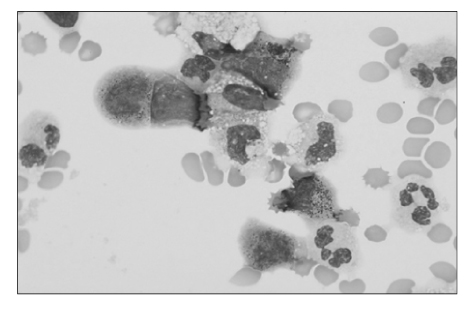Tuberc Respir Dis.
2008 Jul;65(1):49-51. 10.4046/trd.2008.65.1.49.
A Case of Acute Myeloid Leukemia with Multilineage Dysplasia accompanying Malignant Pleural Effusion
- Affiliations
-
- 1Department of Clinical Pathology, College of Medicine, Soon Chun Hyang University, Seoul, Korea. rpark@hosp.sch.ac.kr
- 2Department of Internal Medicine, College of Medicine, Soon Chun Hyang University, Seoul, Korea.
- KMID: 1478217
- DOI: http://doi.org/10.4046/trd.2008.65.1.49
Abstract
- We report a case of acute myeloid leukemia with multilineage dysplasia accompanying malignant pleural effusion. A 73 year-old male patient was admitted complaining of febrile sensations and right chest pain. The cytology of the pleural fluid revealed malignant pleural effusion showing many blasts, which had previously been identified in his bone marrow when he was diagnosed with acute myeloid leukemia with multilineage dysplasia two months earlier. His age and poor general condition had precluded chemotherapy with the exception of hydroxyurea and conservative treatment. Unfortunately, he succumbed to the disease 4.5 months after diagnosis. This case highlights the importance of determining if the pleural effusion of acute leukemia is malignant or not because it can suggest a pleural metastasis and influence the prognosis.
Keyword
MeSH Terms
Figure
Reference
-
1. Haas AR, Sterman DH, Musani AI. Malignant pleural effusions: management options with consideration of coding, billing, and a decision approach. Chest. 2007. 132:1036–1041.2. Fatih T, Selim Y, Mesut A, Demirel YN, Yuksel P. An unusual cause of unilateral pleural effusion in the setting of aortic stenosis: acute myeloid leukemia. Intern Med. 2007. 46:325–327.3. Yim JJ, Lee JH, Yoo CG, Chung HS, Han SK, Shim YS, et al. The incidences and characteristics of malignant pleural effusions according to histologic types. Tuberc Respir Dis. 1998. 45:565–573.4. Alexandrakis MG, Passam FH, Kyriakou DS, Bouros D. Pleural effusions in hematologic malignancies. Chest. 2004. 125:1546–1555.5. Disel U, Yavuz S, Paydas S, Sahin B, Zeren H. Extramedullary relapse in the pleura in acute promyelocytic leukemia. Leuk Lymphoma. 2003. 44:189–191.6. Dix DB, Anderson RA, McFadden DE, Wadsworth LD. Pleural relapse during hematopoietic remission in childhood acute lymphoblastic leukemia. J Pediatr Hematol Oncol. 1997. 19:470–472.7. Ruckdeschel JC. Management of malignant pleural effusions. Semin Oncol. 1995. 22:58–63.8. Light RW, Hamm H. Malignant pleural effusion: would the real cause please stand up? Eur Respir J. 1997. 10:1701–1702.
- Full Text Links
- Actions
-
Cited
- CITED
-
- Close
- Share
- Similar articles
-
- Dasatinib (Sprycel®)-Associated Acneiform Eruption Improved by Dose Reduction due to Pleural Effusion in a Patient with Chronic Myeloid Leukemia
- A Case of Leukemic Pleural Infiltration in Atypical Chronic Myeloid Leukemia
- Diagnostic Utility of Pleural Fluid Soluble Triggering Receptor Expressed on Myeloid Cells 1 Protein in Patients with Exudative Pleural Effusion
- Diagnostic Value of LDH and its Isoenzyme in Pleural Effusion
- Four Cases of Malignant Pleural Effusion in Patients with Papillary Thyroid Carcinoma



